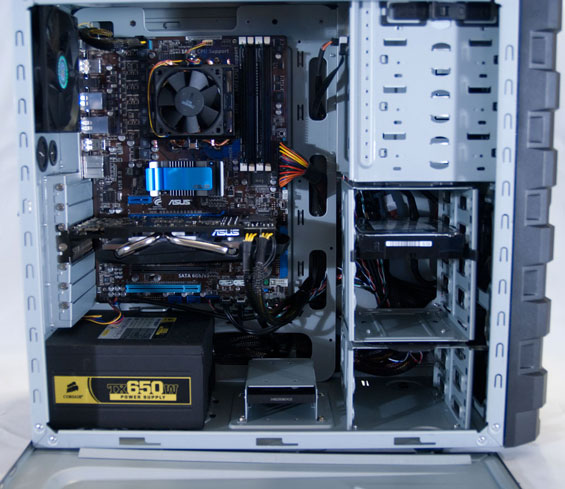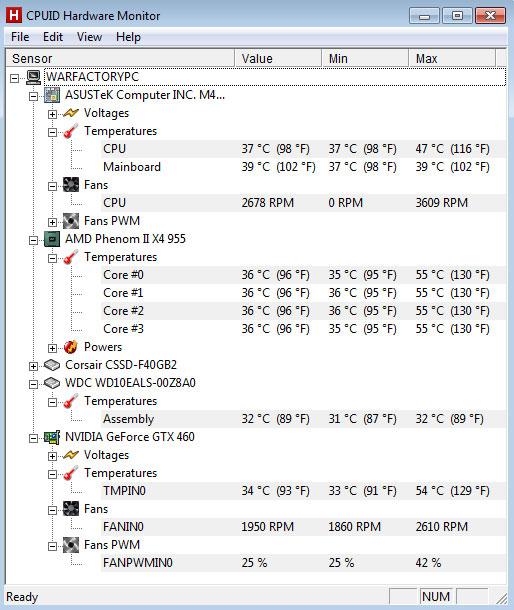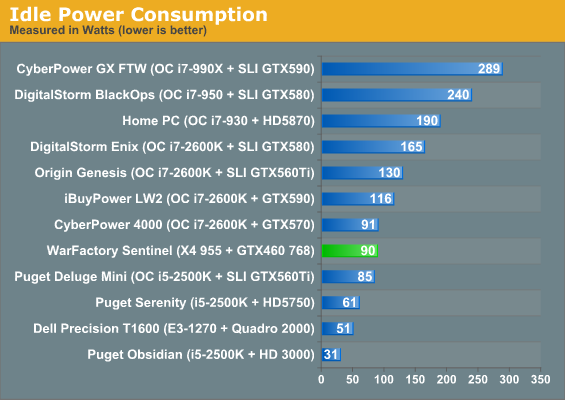WarFactory Sentinel: Gaming on a Grand
by Dustin Sklavos on June 8, 2011 12:01 AM ESTBuild, Noise, Heat, and Power Consumption
Keeping in line with the WarFactory Sentinel's "balanced budget" aspirations, cooling is handled by the custom cooler on the ASUS GeForce GTX 460 768MB TOP (phew), AMD's stock cooler for the Phenom II, and the two 120mm fans the CoolerMaster HAF 912 ships with. Since none of the components are particularly power hungry (as you'll see below), none of the fans have to work too hard, and the result is a reprieve from the noisy gaming systems I've been testing of late.
It's the balance that I really appreciate with WarFactory's component choices in the Sentinel. There's no shame in wanting to build a "sky's the limit" performance machine, but I think there's really an art to building within a budget. When I'm building a machine for friends or family, I live for that, so a system like the Sentinel that really hits the sweet spot and includes a lot of the same component choices I might have made is appreciated. The only questionable decision I feel like they made was the use of G.Skill instead of a more reputable brand like Kingston or Corsair or Crucial, but WarFactory is willing to back it up with a lifetime warranty and RAM is at the commodity item level where differences usually only matter for overclockers.

When we're talking about budget, it's important to see just how much it would cost to build the system yourself, and in that situation (assuming no shipping or sales tax) you're basically paying about $200 for WarFactory to build it for you. To me that seems fairly reasonable; the company is still cutting a profit but not an obscene one, and you're basically paying for a lifetime service plan for the computer. Compare that to paying $300 to Best Buy for one of their insane extended warranties and it seems like a much better deal.

At this point the proof is really in the pudding, so to speak. The thermals for the Sentinel are frankly outstanding; even the graphics card isn't hitting 60C. It's a welcome change of pace, especially when you realize the Sentinel runs very quietly. Outside of the Puget Systems builds and the Dell Precision, this is the quietest desktop I've tested and would be a fine choice for anyone who needs a powerful computer on a budget and doesn't want to have to worry about a jet turbine in their bedroom or office.


While AMD's chips do tend to be less power efficient than Intel's, it's basically a wash in power consumption. The Sentinel's idle consumption is still perfectly reasonable, while load consumption ranks among the lowest (thanks to the use of a single moderate GPU and lack of overclocking). Once you factor a decent video card into the equation, most of Intel's power savings evaporate.
















37 Comments
View All Comments
f4phantom2500 - Wednesday, June 8, 2011 - link
but i just couldn't justify spending $1,000 on a system if it doesn't have at LEAST a Core i5 750, if not Sandy Bridge (read: it should have Sandy Bridge). Also, as solid as the GTX 460 is, I would expect something beefier when dropping that kind of cash. Kudos to having a good SSD, but 40GB sounds like it'd be pretty cramped on a Win 7 64 install. I'm using 24GB of my 64GB Microcenter G2 SSD with Windows 7 Ultimate, and that SSD set me back about $100 (The Corsair Force F40 costs $110 on newegg right now).However, I do like the approach of a fast SSD and a big hard drive for storage, and the 8GB RAM is a nice touch (as mentioned in the article, a wise move considering how cheap RAM is these days). This computer is actually very similar to mine, and I am completely satisfied with it.
Overall, this is a good computer, and I understand computer manufacturers need to make money (the $200~300 markup sounds reasonable, considering the unexpected pitfalls that inevitably come up with building your own system), but I think they could have made some wiser choices in this build.
TrackSmart - Wednesday, June 8, 2011 - link
I agree. If they used a 64GB SSD and a Core i5 750 they could have sold the system at a similar price and ended up with better build. Still, it's a much better selection of components than I've seen from any of the big PC makers (Dell, HP, etc) and the long warranty deserves some kudos...Sunburn74 - Wednesday, June 8, 2011 - link
For $1000 a much more powerful system can be assembled. If power isn't your interest,that $250 could be spent on a nicer case, nicer peripherals (a 27in monitor, etc), etcA user would be better off buying a dell xps desktop or similar product from a number of manufactueres and throwing in a gpu if warranty support is truly an issue.
mino - Wednesday, June 8, 2011 - link
That assumes:a) customer can, or for that matter WANTS, to
- spent their time choosing components and assembling
- troubleshooting any issue that might come up
b) customer deems Dell's component choice/freedom acceptable
While I never buy boxen prebuilt, I strongly feel that this enthusiast pre-occupation of "how you can make it a DIY" while reviewing complete systems is stupid.
People that are in the market for boutique setup ARE NOT interested in hearing how they can do it themselves.
While a nice BOM-vs-price point is welcome, criticising such companies for their pricing is silly. The testing, warranty customizability and service is part of such a product and is not free.
No I am not in this business, never been.
karielash - Wednesday, June 8, 2011 - link
Nice comments, good to see someone with a brain for a change.I spent 2K on a boutique system, going for a balance of performance and price, although I could have easily built my own for the money and maybe even got a little more. I was more than willing to shell out the cash for a pre-built system (with on-site support) and not have the hassle of building the damn thing myself, money well spent imo.
TrackSmart - Wednesday, June 8, 2011 - link
I build my own systems, but I don't kid anybody that I'm saving money once you factor in the massive amount of time invested. It takes hours of research to pick the right components. Many more hours building and troubleshooting. And further hours setting up exchanges if one of the parts is dead on arrival.That said, I build my own systems because I enjoy all of that stuff and take great satisfaction in the final product. If I've saved $200 after all is said and done, that's a bonus. Assuming I've spent 20 hours of my time from research to final build, that's $10/hr. If you don't enjoy doing this stuff, you are much better off buying a nice system like this and spending that extra 20 hours actually using it.
Lunyone - Wednesday, June 8, 2011 - link
This is a decent build that covers most areas of computing needs (office work, gaming, etc.). It's more than I'd pay for a system like this, but I build my own, so that isn't a fair shake. If I didn't know any better (or didn't know how to build computers) I'd say this would be a good deal (of coarse, I'd have to ask around to see if War Factory was reputable).I think the SSD is good for snappiness/resposiveness, but only 40gb's? I think a 64gb SSD would be a better selection for the main boot drive, since you'd have room for a few programs to reside on the boot drive for better resposiveness.
Overall the system looks pretty good, especially since they used a reputable PSU (thank god). I would also agree that a good 500w PSU is more than enough for this build, even a quality 400w PSU is plenty. It is nice that the PSU leaves room for future upgrades, so that is nice too.
P.S. Last sentence has a typo:
in other words, you can get similar or better performance at lower prices and still have money left for a <b>decend</b> SSD (or a 2-year extended warranty).
I think you meant "decent" not decend on the last line. :)
voidi - Wednesday, June 8, 2011 - link
This system is quite interesting because it pretty much chooses the opposite route of most of the other boutique manufacturers.The reason for most of the criticism when looking at a pre-configured build is, that components are simply chosen by their marketing value, that is: a cool looking, cheap case, a huge PSU, high clock rates and as much GDDR as possible for CPU and GPU and sometimes extreme, useless amounts of RAM (16GB). Big numbers mean it's good, right?
All the other aspects, such as a practical case, 3rd party CPU cooling and a focus on a GFX card with good cooling for decent noise and thermal characteristics, and a high quality and efficiency PSU with less unused capacities are were the money is usually saved and what often turns a seemingly great deal into a rip-off.
In this scenario, some of these rules are turned around. The PSU is still way too big, but it's from a quality manufacturer. The case is unusually practical, good noise and thermal characteristics for little money, form follows function. As mentioned before, this kind of warranty being included in the price is not something you see often nowadays either. 8 GBs of RAM are not something many people are going to need anytime soon, but RAM has gotten cheap enough to take it while you're at it. 40GBs is possibly a bit small, although the idea of a small, dedicated SSD for the OS is of course entirely reasonable. I would've preferred to see 64GBs here.
As for the GTX 460, I would've liked to see a quieter, more efficient Radeon instead, and I do not think it's smart to cheap out on the CPU, with the i5-2500 simply offering the best bang for the buck, in my opinion. A H67 motherboard going with that would be a smart an inexpensive choice, as I don't think the average buyer of boutique PCs is going to overclock his CPU at all, especially not with a box cooler. Finally, a 1TB HDD is industry standard as of now, also something I don't approve. I have a 750GB internal HDD and a 500GB external right now, and both are coming close to being full. A 2 TB HDD is entirely reasonable and affordable today.
In conclusion, I like that WarFactory is trying to "do the right thing" from a practical, value-oriented perspective, in some of the aspects. It mixes up the boring landscape of "big number" boutique machines that are configured purely for marketing reasons.
I still would not buy the Sentinel, but I have never felt interested to buy any pre-configured PC, as a custom-built will always be able to offer exactly what I want, and not half the features plus a couple of useless ones plus a 200$ fee for the middle-man. But that's just my opinion.
Wurmer - Wednesday, June 8, 2011 - link
It's interesting to see a company taking the less travel path. I have been switching back and forth between AMD and Intel rigs for years and I am happy to see that someone, somewhere acknowledge the value of AMD CPU. It's a given that this system doesn't compete with an Intel equivalent but it's beside the point. Up this very recently, I had a rig pretty similar to this one but my CPU was an unlocked BE 555 which is basically the same CPU and my GPU was an OC'ed 460. Honestly, there was no tasks that this computer couldn't do at a decent pace. I'd say that a rig like that is plenty powerfull for a majority of people that doesn't the very best with bleeding fast performances.It's a good compromise between buying in a retail store and building your own. I don't buy pre built rig but that's a system I could see myself recommand to someone that isn't to much into computer but needs a decent system.
DonMiguel85 - Wednesday, June 8, 2011 - link
Sorry to go OT, but... whatever happened to the Rockus 3D prize giveaway? I never saw any update on it.